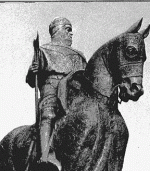After seeing the Braveheart movie for the 5th time, I decided to do research and understood that to portray the real Battle of Stirling Bridge, might not be as entertaining ( big, bad heavy English knights charged onto rickety bridge, bridge falls down, taking the bad English knights with it, leaving weak ,now leaderless ,light infantry and auxilleries to deal with.......)History channel did a Search For Braveheart show, that I thought was well done and seemed reasonbly historically substantiated......Any one see this program and their thoughs? Also The Bruce, not really a nice guy......killed his unarmed rival for the throne ,in a church sanctuary, during prayers.......Michael
Hi Maddadicus,
I've come back to this one now I've had a real think about it. Please bear with me cos I don't have access to my book collection at the moment, but I'll try and address the points you've made from memory.
I'm not sure that I completely agree that portraying the real battle with the rickety bridge wouldn't have been as entertaining as a "Pseudo-Highland Charge" across a field was. Be that as it may, there's no denying that the battle scenes in Bravefart were awesome. I guess it was more the hollywood invention of a tryst between WW & the Princess of Wales that scunnered me off the movie. Remember that the movie was released while the death of the more recent P of W was still an issue in the UK media at the time. Seemed to me like Randal Wallace couldn't help but tap into that sense of loss when he wrote the screenplay, so right away, the audience vote went to the P of W.
In addition, and you can trust me on this, the way the politicians in Scvotland latched onto the movie had to be seen to be believed. It was all
Braveheart this and Freedom that. And what was the first thing they did when we got devolution of parlimentary power from Westminster - they voted themselves a pay rise and okayed the erection of that monstrosity parlimentary building in Edinburgh, that ended up being waaaaay over budget by the time it was finished. Aye, some things never change. "Such a Parcel Oh Rogues in a Nation" as was said during the union of parliaments in 1707 right enough.
Anyway, leaving 1707 alone and getting back to circa 1314. While there's no denying that Bruce murdered the Red Comyn in front of the alter in Dumfries, may I suggest that this is considered within the context of the times.
The story goes that William Wallace did indeed have a swordbelt made out of Cressinghams flayed skin after Stirling.
Edward 1st slaughtered the entire population of Berwick (at that time, a Scottish city) - including men, women and children - then left them lying unburied in the streets for weeks as a
warning....!!! I think this was just after the Battle of Dunbar, which put paid to John Balliol's half-hearted rebellion.
During the Battle of Roslin (1308? I think), the Scottish army commanded by the Red Comyn (a cousin of Balliol) slaughtered all their English prisoners at a crucial point in the battle when it seemed they might be rescued and released by their country-men.
When Edward 1st caught up with Bruces wife and the rest of his family and attendents who had been sent north to Kildrummy Castle for safety after Bruce's crowning and swiftly thereafter defeat at Methven, he had Bruces brother Nigel hung, drawn and quartered, the Earl of Atholl was hanged on a 30-ft high gibbet, Queen Elizabeth de Burgh daughter of one of Edward's greatest supporters, the Earl of Ulster, was sent to exile in a nunnery and didn't see her husband again until she was ransomed after Bannockburn, Isabel the Countess of Buchan who crowned Bruce at Scone was hung in an open cage on the walls of Roxbourgh Castle for several years as was Bruce's sister, Katherine? I think her name was.
When Bruce returned to mainland Scotland after hiding out in Ireland (or it might have been Rathlyn Island where he met up with his famous spider), Edward 1st caught his two youngest brothers Alexander, and I'm not sure but I think the youngest one was called Christian; and they were promptly hung, drawn and quartered as well.
All this against a background of civil war between the Bruce and Balliol/Comyn factions - with all the savagery that suggests.
Getting back to the "lovely" Princess of Wales, she was the one who suggested to her lover Mortimer how they could dispose of good ol' *** Eddie 2nd without a wound being evident on his body. The plan involved a red-hot poker being inserted into his rectum and as you can imagine, it succeded leaving the way open for Edward 3rd to mount the throne of England and thereafter sponsor the 2nd War of Scottish Independence a generation on from Wallace, Bruce, et al.
There's much, much, more. I haven't even touched on Sir James Douglas (The Black Douglas) - Good Sir James to the Scots - The Devil Incarnate to the English. The story of "Douglas's Larder" is particulary bloodthirsty.
Not a particularly nice bunch of people back in the 13th/14th century

All of what I've described here is a matter of record.
Hope this loooooooong post puts Bruces murder of the Red Comyn into perspective.
Wish I could lay my hands on a DVD of that History Channel "Search for Braveheart" programme though.



